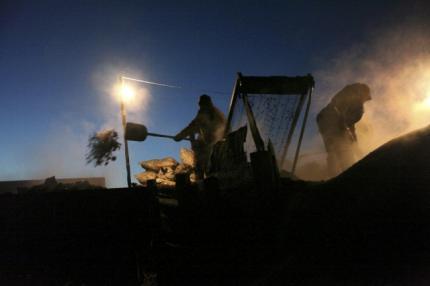Asian coal miners, traders face up to grim realities
Bareksa • 04 Jun 2014

Workers shovel coal at a coal mine (REUTERS/B.Rentsendorj)
The price has almost halved since its post-2008 recession peak of $136.30 a tonne.
Bareksa.com - "There is no skin left on my teeth to hang on with," was the lament of a coal trader, expressing a sentiment echoed time and again at the industry's largest gathering in Asia.
Normally coal miners, traders and shippers are a fairly optimistic bunch, their good humour likely shaped by a tough industry that is increasingly unloved across the world despite being essential to keeping the lights on.
But the mood at the Coaltrans Asia conference in the Indonesian resort island of Bali this week was subdued, and the question on everybody's lips was how much lower can coal prices go.
At a roundtable session, a well-known analyst talking about the outlook for prices was mobbed, while an expert on valuing coal mines cut a lonely figure, underscoring that nobody is currently interested in investing in coal production.
The price of coal at Australia's Newcastle Port , an Asian benchmark, fell to $73.89 a tonne in the week to May 30, down 14.3 percent so far this year and close to the 4-1/2 year low hit in March.
The price has almost halved since its post-2008 recession peak of $136.30 a tonne, reached in January 2011, making it easy to understand the pain being felt by miners and traders.
Of course, coal buyers, particularly those in India, are relishing the low prices and as one trader put it, they are enjoying kicking the supply side of the industry when it is down.
Indian buyers have been demanding longer payment periods, stretching the normal 30 days to 90 days, and then when this falls due, they have been insisting on only paying the current spot price, not the cost agreed three months earlier when prices were higher, according to one trader at the conference.
In a highly oversupplied market, miners, traders and shippers have little choice but to acquiesce and hope they can keep their heads above water for a little while longer.
During a conference session on pricing, the audience was asked pick the expected floor price for Newcastle coal using an electronic voting system, and the most popular choice was $70 a tonne, beating $65 a tonne into second place.
Since the majority of the participants at the conference are from the supply side of the industry, it was to be expected that they felt the bottom for prices is near.
But this view is based more on hope than any real sign that coal prices are ready to stage a rally.
For prices to rise it's obvious there needs to be a spike in demand or a cut in supply or a combination of both.
Over the next few months it's hard to see this happening, even as seaborne volumes remain robust.
Top importer China is only buying imported coal because it's cheap and can compete with domestic supplies.
The domestic market sets the import price in China, and with top producer China Shenhua Energy Co Ltd recently lowering prices amid soft demand, it's unlikely that China will provide impetus for higher prices.
Indian coal buyers are also active, but once again it's clear that low prices are helping to drive their import volumes, and any rally will likely result in slower import growth.
Japan's coal demand has risen with the idling of its nuclear power fleet, but is likely at the upper limit as the coal-fired plants are operating at high rates.
With few strong demand drivers, it falls to the supply side to spark a recovery in prices, and this looks unlikely as well.
TAKE OR PAY HURTING PRICES
The main problem identified by the Coaltrans delegates is Australia's "take or pay" contracts, which basically force miners to pay for rail haulage and port capacity whether they ship coal or not.
Initially planned as way of guaranteeing revenue in order to secure funding to build expensive infrastructure, these contracts have become an albatross around the necks of miners, forcing them to produce at a loss as the cost of shutting down pits is more expensive.
This has resulted in Australian mines chasing higher volumes in order to lower costs, resulting in more coal flowing into an already oversupplied market as Indonesian producers also boost output to maintain market share.
Australia is the world's largest exporter of coal, shipping both coking coal for use in steel-making and thermal coal for power generation. Indonesia is the world's largest shipper of thermal coal.
While there have been some recent announcements of shutdowns or lower output by some Australian producers, these amount to small volumes and are unlikely to do much to resolve the oversupply situation.
It seems more likely that coal producers will try to hang for as long as possible in the hope of better times ahead.
Certainly, most forecasts are for strong gains in coal demand in the next decade in Asia, with consultants HDR Salva expecting demand gains of 50 million tonnes a year.
This is based on emerging coal consumers in Southeast Asia, such as Thailand and Malaysia, and increasing imports by India and China.
But these forecasts may prove optimistic as the "war on coal" ramps up worldwide, with the United States acting to cut coal use and suggestions that China may impose a cap on emissions within the next few years.
Longtime coal industry players point out that they have seen tough times before and always managed to survive. What's becoming clearer is that prices have shifted structurally lower, and at some point the industry is going to have to take the pain of curbing supply. (Source : Reuters)